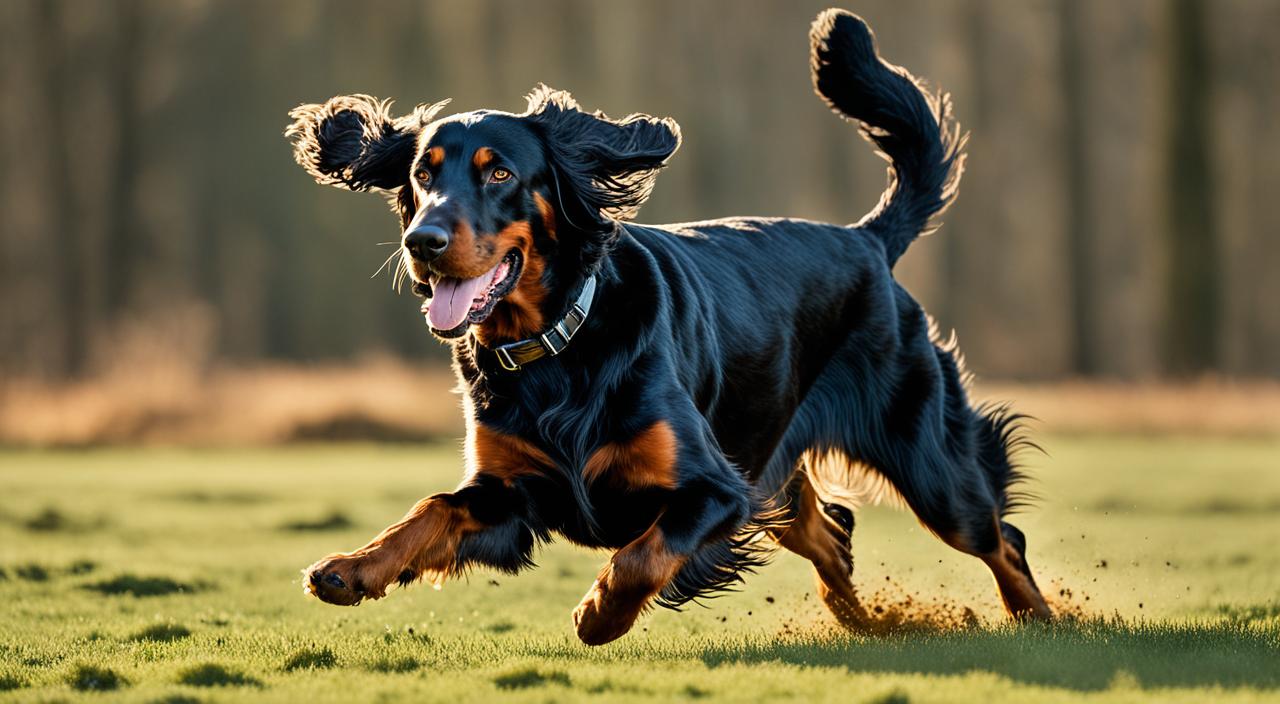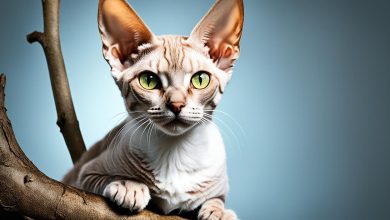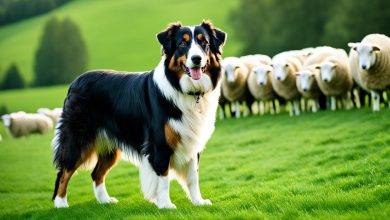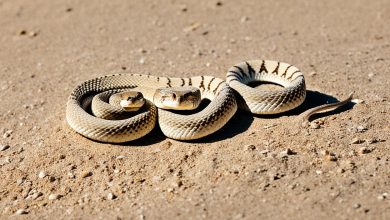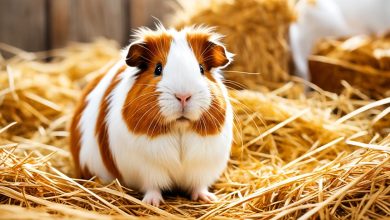A majestic black and tan figure emerged from the Scottish highlands’ heather. The Gordon Setter, with its regal stance, captured my heart instantly. This pointing breed embodies the spirit of the rugged landscapes it calls home.
The Gordon Setter is a large hunting dog breed with a striking appearance. Originally bred for hunting pheasants and quail, these dogs have become beloved companions for active families.
Gordon Setters stand 23-27 inches tall and weigh between 45-83 pounds. They are the largest of the setter breeds. Their long, thick black coats with tan markings are stunning.
These elegant sporting dogs have a lifespan of 10-12 years. They offer families a decade or more of companionship. Their alert and confident nature makes them excellent family pets.
Gordon Setters require high exercise needs. Their affectionate temperament balances well with their active lifestyle. These dogs thrive in homes that can provide plenty of physical activity.
The Gordon Setter has seen a decline in popularity recently. In 2018, only 172 puppies were registered. This led to its designation as a ‘vulnerable native breed’ by the Kennel Club.
The Origins of the Gordon Setter
The Gordon Setter, a majestic Scottish gun dog, has a rich history dating back to the 1500s. It evolved from setting spaniels through careful breeding. This process created a distinct breed with unique characteristics.
From Setting Spaniels to Modern Setters
Setting spaniels, the Gordon Setter’s ancestors, were first mentioned in the late 1300s. By the 18th century, kennels across Britain were producing black and tan setters. These dogs laid the foundation for today’s Gordon Setter.
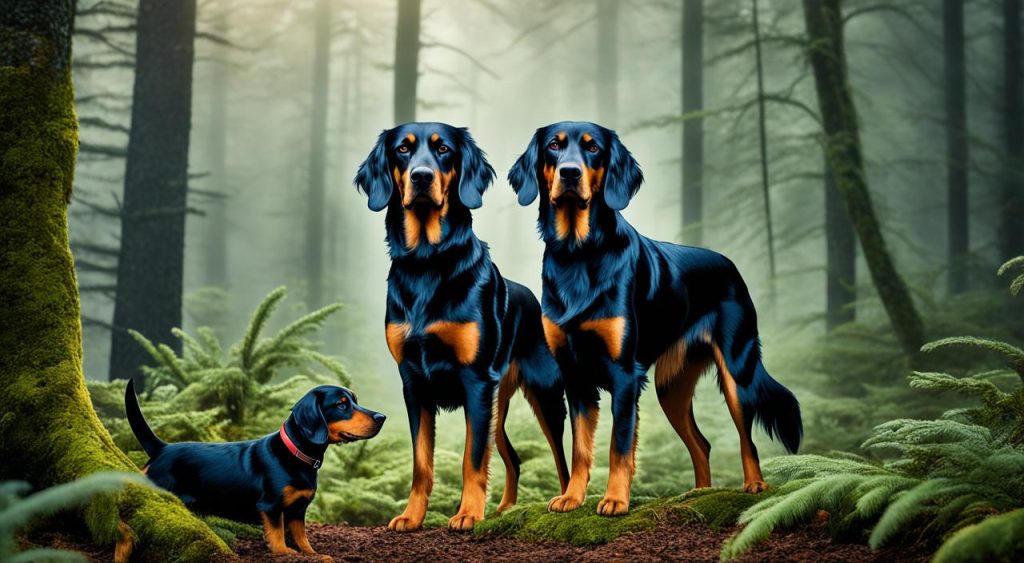
The Duke of Gordon’s Influence
Alexander, the 4th Duke of Gordon, played a key role in developing the breed. He inherited his title at nine and later established kennels at Gordon Castle. The Duke’s setters became famous for their stamina and scenting ability in hunting.
Evolution of the Breed in Scotland
The Gordon Setter developed a heavy bone structure and square shape. These features were ideal for navigating Scottish moors. The dog’s strength and endurance made it a prized hunting companion.
In 1924, Britain’s Kennel Club officially recognized the breed as the Gordon Setter. This recognition cemented its status in the canine world.
Today, the Gordon Setter ranks 99th out of 201 American Kennel Club recognized breeds. It excels in show rings and field trials. The breed continues its legacy as a skilled hunter and beloved pet.
Physical Characteristics of the Gordon Setter
Gordon Setters are majestic black and tan sporting dogs. Their coal-black coats have rich chestnut markings. The medium-length straight coat features feathering, giving them an elegant look.
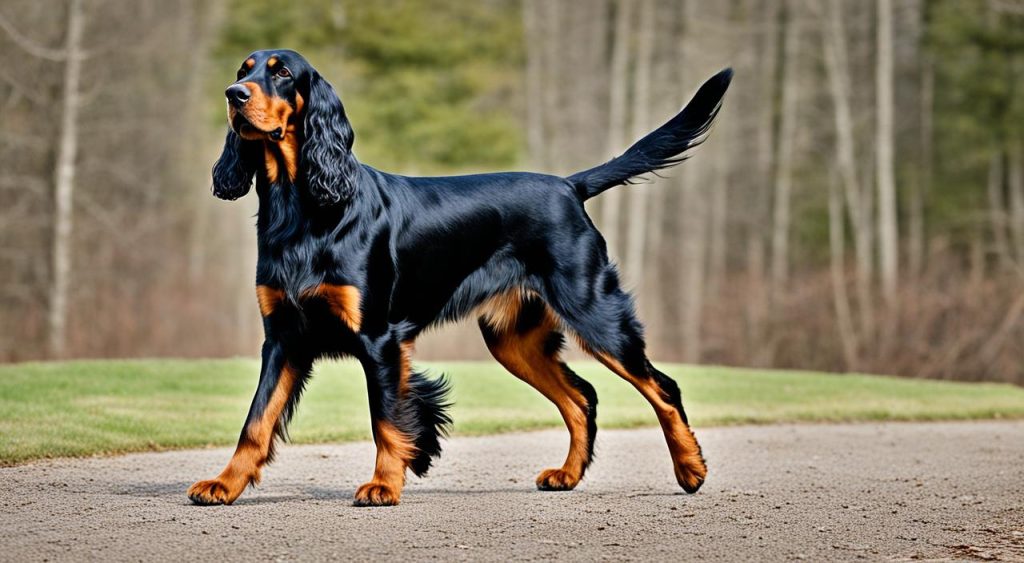
These large, robust dogs can handle harsh weather. Males stand 24 to 27 inches tall and weigh 55 to 80 pounds. Females are slightly smaller, measuring 23 to 26 inches and weighing 45 to 70 pounds.
Gordon Setters have deep heads with long muzzles and bright brown eyes. Their ears are low-set and hang close to the head. They have level toplines, long necks, and muscular hindquarters.
These dogs move with a steady, galloping gait. Their coat needs regular grooming, especially during spring and fall shedding seasons. With proper care, Gordon Setters can live 12 to 13 years.
Temperament and Personality Traits
Gordon Setters are confident and athletic, making them excellent versatile gundogs. These intelligent hunting dogs have a strong-willed nature. They require patience during training due to their independent streak.
Intelligence and Trainability
Gordon Setters are highly intelligent, contributing to their success as hunting dogs. Their sharp minds and natural curiosity make them quick learners. Positive reinforcement works best for these sensitive dogs.
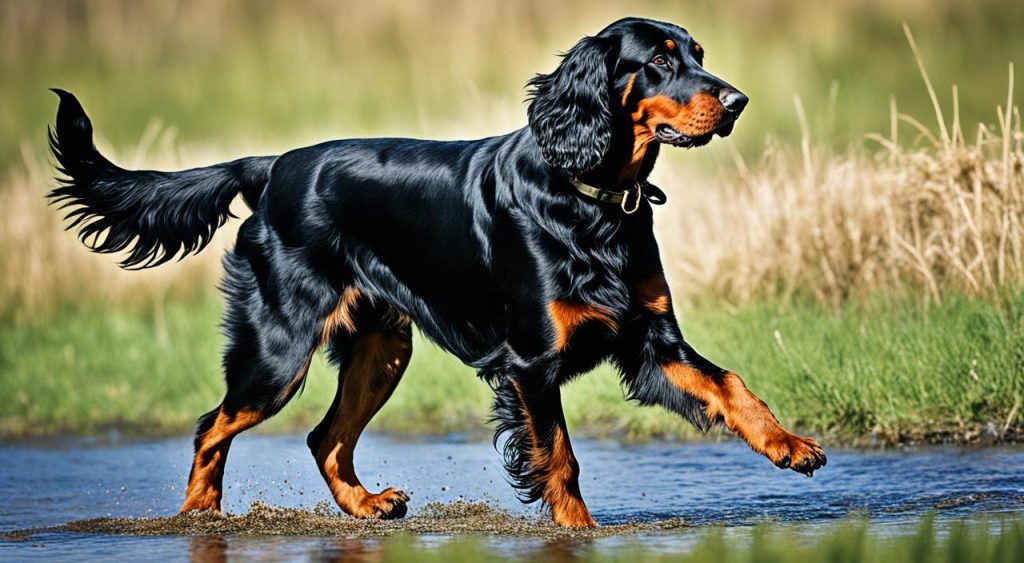
Loyalty and Affection towards Family
These dogs form strong bonds with their families. They often become particularly attached to one person. Gordon Setters thrive on human interaction and can become distressed if left alone too long.
Interaction with Strangers and Other Dogs
Early socialization is crucial for Gordon Setters to develop into well-rounded adults. While generally friendly, they can be reserved with strangers. Proper exposure to various experiences helps prevent behavioral issues.
Gordon Setters typically get along well with other dogs. Their strong hunting instincts may require careful management around smaller pets.
“Gordon Setters are sensitive and empathetic dogs that can be easily distressed by harsh training methods, emphasizing the importance of positive reinforcement and gentle handling in their training.”
Understanding Gordon Setters’ unique traits is key to their care and training. This knowledge helps them thrive as both hunting dogs and family pets.
Gordon Setter: The Largest of the Setter Breeds
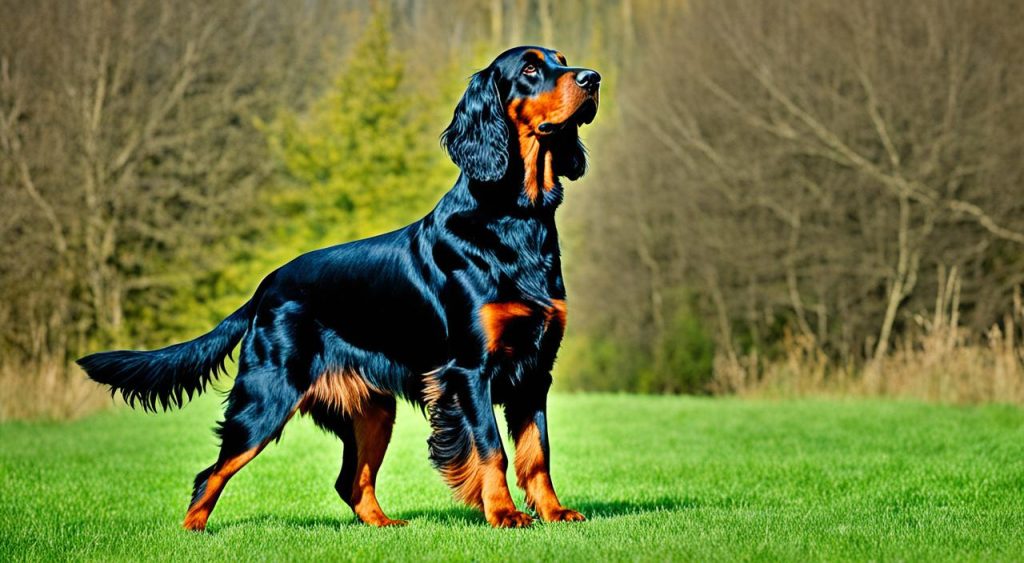
The Gordon Setter is the biggest setter breed. These impressive sporting dogs stand 23 to 27 inches tall. They weigh between 45 to 80 pounds, making them ideal for long hunting days.
Gordon Setters originated in northern Scotland. Alexander the Fourth, Duke of Gordon, developed them for stamina over speed. Their black-and-tan coat distinguishes them from other setter breeds.
The United Kennel Club recognized Gordon Setters in 1872. They were initially called black and tan setters. In 1924, the name changed to Gordon Setter.
| Characteristic | Description |
|---|---|
| Height | 23-27 inches |
| Weight | 45-80 pounds |
| Coat Color | Black with tan markings |
| Exercise Needs | 60 minutes daily, 15 miles weekly |
Gordon Setters need lots of daily exercise. They do best in homes with large, fenced yards. These dogs require at least 60 minutes of activity daily.
Their strong hunting instinct makes them responsive and trainable. Gordon Setters are great companions for active families. Their high intelligence adds to their appeal.
Exercise Requirements and Energy Levels
Gordon Setters are energetic hunting dogs that need lots of daily activity. These gundogs thrive on physical and mental challenges. They have high stamina and require dedicated exercise routines.
Daily Exercise Needs
Gordon Setters need 1 to 1.5 hours of vigorous exercise daily. This can include long walks, runs, or hunting-related activities. Their energy levels demand consistent physical outlets to prevent restlessness.
Suitable Activities for Gordon Setters
These versatile gundogs excel in activities that engage both body and mind:
- Hiking trails
- Swimming
- Fetch games
- Agility courses
- Scent work
Gordon Setters benefit from activities that mimic their working roles. Providing chances to run and play helps release excess energy.
Mental Stimulation Importance
Mental exercise is crucial for this intelligent breed. Puzzle toys, obedience training, and interactive games keep their minds sharp. Regular mental stimulation prevents boredom and potential destructive behaviors.
With proper physical and mental exercise, Gordon Setters become laid-back adult companions. This makes them excellent hunting dogs and family pets.
Health Considerations for Gordon Setters
Gordon Setters, a Scottish breed, typically live 12 to 13 years. These elegant hunting dogs need attentive care to stay healthy. Regular vet check-ups are crucial for monitoring breed-specific health issues.
Gordon Setters face several health challenges. Dental disease affects 80% of dogs by age two. Obesity can lead to joint problems and heart disease.
These dogs are prone to common canine bacterial and viral infections. Eye problems like cataracts, dry eye, and Progressive Retinal Atrophy (PRA) can affect them.
Genetic testing helps identify and manage eye conditions early. Other health concerns include:
- Gastric Dilatation and Volvulus (Bloat)
- Hip and elbow dysplasia
- Hypothyroidism
- Ear infections
Regular exercise and proper nutrition are key to keeping Gordon Setters healthy. Parasite control is also essential. Spaying or neutering can reduce the risk of certain cancers.
With proper care, Gordon Setters can be loving companions and skilled hunting dogs. They can lead long, healthy lives with the right attention.
Grooming and Maintenance of the Gordon Setter
Gordon Setters are black and tan sporting dogs with elegant coats. Their long hair needs regular care to stay healthy and beautiful. Proper grooming keeps these pointers looking their best.
Coat Care and Brushing Routine
Gordon Setters have long, soft coats that can be straight or wavy. Their size makes grooming a big task. Brush your Gordon Setter twice weekly to prevent mats and tangles.
Regular brushing keeps the coat looking great. It also spreads natural oils through the fur. This helps maintain a healthy, shiny coat.
Bathing and Nail Trimming
Gordon Setters may need baths more often than other dogs. Their silky coats can get dirty quickly. Trim nails regularly to prevent discomfort and walking problems.
Many owners worry about cutting nails too short. It’s best to trim long nails gradually. This helps avoid hurting the quick, the sensitive part inside.
Ear and Dental Care
Gordon Setters have floppy ears covered in feathered hair. This makes them prone to ear infections. Check and clean their ears weekly to prevent problems.
Don’t forget about dental care. Brush your dog’s teeth with special toothpaste regularly. This helps avoid common dental issues in dogs.
| Grooming Task | Frequency |
|---|---|
| Brushing | At least twice a week |
| Bathing | Every 1-2 months |
| Ear Cleaning | Weekly |
| Nail Trimming | As needed, typically monthly |
| Teeth Brushing | 2-3 times a week |
The Gordon Setter as a Hunting Companion
Gordon Setters are outstanding bird dogs from Scotland. They shine in the field with natural hunting instincts. These elegant canines show unwavering dedication to their handlers.
Gordon Setters have impressive stamina, running over five miles during hunts. This endurance helps them cover vast terrains. They’re perfect for long hunting trips.
These gun dogs excel at finding and pointing game birds. Their precision makes them valuable hunting partners.
Gordon Setters have a unique hunting style. They quarter the ground efficiently using their keen sense of smell. When they catch a scent, they freeze into a staunch point.
This “steady to wing and shot” behavior is highly valued. It alerts handlers to the presence of game birds.
“Gordon Setters are personal hunting dogs, thriving when sharing both hearth and field with their masters.”
Gordon Setters focus on locating and pointing game, not retrieving. Their intelligence makes them adaptable to various hunting situations. With training, they become invaluable field assets.
| Characteristic | Description |
|---|---|
| Hunting Style | Pointing and Flushing |
| Scenting Ability | Excellent |
| Stamina | High (5+ miles) |
| Trainability | Intelligent and Responsive |
Training and Socialization for Gordon Setters
Gordon Setters are exceptional hunting dogs that need consistent training and early socialization. These intelligent gun dogs thrive on mental and physical challenges. Proper training is crucial for their well-being.
Early Socialization: Building Confidence
Socialization is key to developing well-adjusted Gordon Setters. About 60% of owners stress its importance in building confidence and adaptability. Puppy classes are recommended by 55% of owners.
These classes expose young Gordon Setters to various environments, people, and pets. This early exposure helps them become more confident and social.
Obedience Training Techniques
Positive reinforcement training methods are 60% effective for Gordon Setters. Basic commands like No, Come, Kennel, Stay, and Whoa are essential. These form the foundation of good citizenship training.
For hunting dogs, retrieving drills 1-3 times a week are beneficial. These drills help develop their natural abilities and skills.
Addressing Behavioral Challenges
Gordon Setters can be stubborn and have a strong prey drive. Consistent training and positive reinforcement help manage these traits. Field training for hunting typically starts at 9-12 months old.
Training focuses on ranging, quartering, and pointing skills. Exposing puppies to game birds in hunting-like areas is ideal. This helps their future success as gun dogs.
“Training a Gordon Setter requires patience and understanding. Their intelligence and eagerness to please make them responsive learners when approached with kindness and consistency.”
Proper training and socialization are vital for Gordon Setter owners. These efforts nurture well-behaved, confident hunting companions. With the right approach, these dogs excel in both field and home settings.
Gordon Setters in Popular Culture and Notable Owners
Gordon Setters, elegant Scottish hunting dogs, have gained fame through notable owners. Ed McMahon, Johnny Carson’s sidekick, owned a Gordon Setter named Juniper Berry. This showcased the breed’s loyalty and distinctive black and tan coat.
Diane Sawyer, former ABC News anchor, also owned a Gordon Setter named George. These high-profile owners have raised awareness about these capable hunting dogs. They’ve shown how well Gordon Setters adapt from Scottish Highlands to American homes.
Gordon Setters excel in outdoor activities due to their keen sense of smell. They can cover rough terrain, making them great companions for nature lovers. These “velcro dogs” form strong bonds with their families over their 10-12 year lifespan.
FAQ
What is the origin of the Gordon Setter?
The Gordon Setter hails from Scotland, developed in the 18th century. Alexander, the 4th Duke of Gordon, bred these dogs for their stamina and game-finding skills. The Kennel Club officially recognized the breed in 1924.
What are the physical characteristics of the Gordon Setter?
Gordon Setters are large dogs with coal-black coats and rich chestnut tan markings. They have deep heads, long muzzles, and bright brown eyes. Their muscular bodies feature low-set ears, sloping shoulders, and long, straight tails.
What is the temperament of the Gordon Setter?
Gordon Setters are intelligent, bold, and outgoing dogs with strong bonds to their owners. They can be headstrong and independent, needing firm but gentle handling. Early socialization helps them interact well with people and other animals.
How do Gordon Setters compare to other setter breeds?
Gordon Setters are the heaviest and largest of the setter breeds. They outweigh Irish Setters, Irish Red and White Setters, and English Setters. Their stamina, intelligence, and excellent memory make them ideal for long field days.
What are the exercise requirements for Gordon Setters?
Gordon Setters need at least two hours of daily physical activity. They enjoy long walks, runs, and hunting-related exercises. Mental stimulation is crucial to prevent boredom and destructive behaviors.
What are some common health concerns for Gordon Setters?
Gordon Setters may develop hip and elbow dysplasia, eye problems, and hypothyroidism. They’re also prone to bloat. Regular health screenings and check-ups are vital for their well-being.
What are the grooming requirements for Gordon Setters?
Gordon Setters have long, thick coats that need brushing more than once a week. Regular bathing, nail trimming, and ear cleaning are essential. Don’t forget about their dental care too.
How are Gordon Setters utilized as hunting companions?
Gordon Setters excel at hunting game birds. They range far, quartering the ground to locate game. These dogs remain staunch at point until the handler arrives. Then, they flush the bird and stay steady.
What training is recommended for Gordon Setters?
Early socialization and obedience training are crucial for Gordon Setters. Focus on basic commands and responsiveness to hand signals and whistles. Address potential stubbornness and strong prey drive early on.
Field training for hunting typically starts when the dog is 9-12 months old.
Have any notable figures owned Gordon Setters?
Ed McMahon from “The Tonight Show” and ABC News anchor Diane Sawyer have owned Gordon Setters. Their ownership has helped raise awareness of these elegant hunting dogs.
